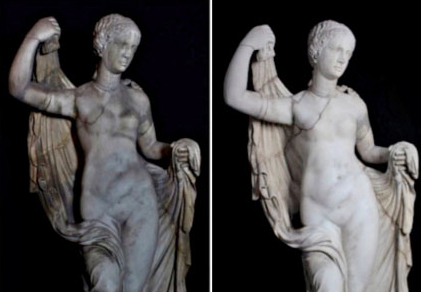The recently restored statue of Aphrodite housed in the Museo Archeologico Nazionale (National Archeological Museum/the Museum) in Florence, Italy, was unveiled in a public celebration on September 11, 2018. Funded by Friends of Florence with a donation by Michael and Sandy Collins, the cleaning and restoration process revealed a surprising development. Long thought to be a representation of the Spartan queen Leda that had been marred with dirt and grime over centuries, it was discovered to be the Greek goddess Aphrodite sculpted in now immaculately white marble.
New source research during the restoration led to the identification of the statue as the one purchased in 1882 by Luigi Adriano Milani, then director of the Museum. It came from Palazzo Da Cepparello, in Florence. The building originally belonged to the Portinari family (Dante’s great love, Beatrice, was a Portinari). Subsequent owners include the Salviati family (a daughter Maria married Cosimo I de’ Medici). From its origins as a stately home, it later became a bank and is now being redesigned as apartments.
The statue has been identified as a good, first century A.D. Roman copy of a Hellenistic original dating from around 300 B.C. Restorers discovered that the marble (from the island of Paros) used for the body is different from the material of the head, which they revealed is antique but not original. The arms were sculpted and added in the eighteenth century when it was customary to repair broken statues by adding ancient or specially-made parts to make them whole and “beautiful,” in keeping with the times.
Before starting the restoration, which was conducted by Daniela Manna and assistants, the statue was photographed and subjected to a series of diagnostic studies aimed at identifying any original polychrome, traces of which were indeed found on the drapery and hair (red ochre and gilding). After having analyzed the conservation condition and identified alterations and deterioration, the restoration team selected the most appropriate methods and tools for cleaning, partially removing previous restorations and repairing lacunae. The cleaning was done with a laser device that gradually removed the black incrustations. The final phases involved re-gluing an original fragment using the same types of materials as in antiquity—materials which are still valid and appropriate for a statue displayed inside a museum.
Provenance research unearthed a catalogue entry and photography from the late 1800s of the statue in the Museum’s garden loggias which corroborated the figure’s identity. The “rediscovered” Aphrodite, on her beautifully carved, early nineteenth-century wooden base, will remain where she was studied and restored, on the ground floor and visible to all who enter the Museum.
Project details
The restoration was conducted with a grant from the Friends of Florence, through a gift from Michael and Sandy Collins.
Restorer: Daniela Manna
Assistants and photographic campaign: Simona Rindi, Serena Tizzanini, Carmine Santillo
Petrographic analyses: Emma Cantisani, Silvia Vettori (Istituto per la Conservazione e la Valorizzazione dei Beni Culturali – National Research Council, Florence)
Diagnostics: Andrea Rossi, Shao-Chun Huang (Diagnostica per i Beni Culturali)
Handling: Apice SCRL Florence
